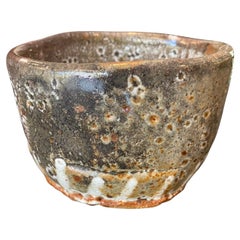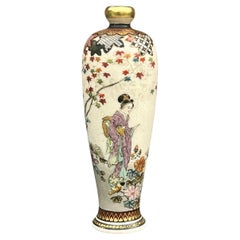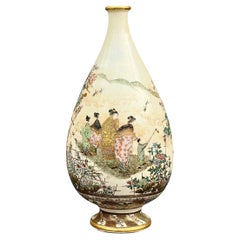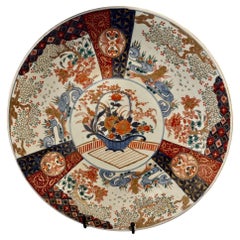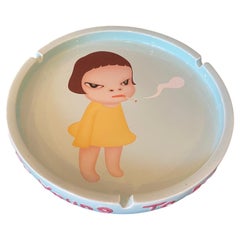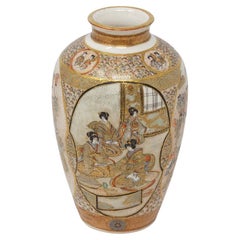Japanese Ceramics
to
372
514
392
948
521
31
35
10
6
4
4
4
3
1
58
463
427
552
161
101
44
34
3
7
11
4
8
3
6
5
3
1,433
931
388
234
103
3,883
3,605
1,989
1,500
165
1,500
1,485
1,485
28
17
17
14
9
Place of Origin: Japanese
Japanese Asian Signed Studio Pottery Wabi-Sabi Ceramic Glazed Chawan Tea Bowl
Located in Studio City, CA
A gorgeous Japanese studio pottery chawan tea bowl that features a mix of shifting colors, glazes and textures as well as elements of Shino Ware and Hagi Ware. The piece radiates in...
Category
20th Century Showa Japanese Ceramics
Materials
Earthenware, Pottery
A Fine Japanese Satsuma vase signed by Ryokuzan. Meiji period
Located in London, GB
A exquisite Satsuma vase signed by Ryokuzan.
Meiji Era.
Of a slender ovoid shape featuring intricate hand-painted designs and delicate gilded accents.
The vase is adorned with...
Category
19th Century Antique Japanese Ceramics
Materials
Ceramic, Porcelain
A Fine Japanese Satsuma Vase . Meiji Period. Kinkozan
Located in London, GB
A Fine Japanese Satsuma Vase with Bijin, Peacock, and Chrysanthemums.
Attributed to Kinkozan Workshop, Kyoto, Meiji period (late 19th century)
Of pear-shaped form with a flared f...
Category
19th Century Antique Japanese Ceramics
Materials
Ceramic, Porcelain
Large 16" Imari Charger, Meiji Period
Located in Pasadena, CA
This impressive large Imari Charger dates to the later Meiji period. The charger features a central reserve of a traditional Japanese flower basket which is surrounded by reserves of...
Category
Late 19th Century Anglo-Japanese Antique Japanese Ceramics
Materials
Porcelain
Yoshitomo Nara, Too Young to Die, Japanese Glazed Porcelain Ceramic Ashtray 2002
By Yoshitomo Nara 1
Located in Studio City, CA
A beautiful and highly coveted large finely glazed ceramic ash tray/ low bowl by famed Japanese Pop artist Yoshitomo Nara (奈良 美智, 1959- ) titled "Too Young To Die". The wonderful im...
Category
Early 2000s Modern Japanese Ceramics
Materials
Ceramic, Porcelain
Antique Japanese Meiji Period Satsuma Vase by Ryozan
Located in Newark, England
MEIJI PERIOD 1868-1912
From our Japanese collection, we are delighted to offer this Japanese Satsuma Vase by Ryozan. The vase of tapered form with tightly pinched neck and flared to...
Category
Late 19th Century Meiji Antique Japanese Ceramics
Materials
Ceramic, Earthenware, Pottery
A Large Imperial Satsuma Vase by Toshinobu, Meiji Period
Located in London, GB
A Large imperial Satsuma Vase
Signed Toshinobu (年信), Meiji Period (late 19th century)
Of baluster form with a flared rim, finely decorated in gilt and polychrome enamels on a crackl...
Category
19th Century Antique Japanese Ceramics
Materials
Ceramic
Large Japanese Arita Porcelain Hibachi Planter
Located in Palm Springs, CA
Very large and heavy hand painted blue and white porcelain Japanese Arita porcelain Hibachi used as a planter. Decorated with various symbols...
Category
Mid-20th Century Japanese Ceramics
Materials
Porcelain
Antique Japanese Okimono Kutani Red-Robed Bodhidharma Monk Daruma Figure Statue
Located in Studio City, CA
A beautiful Japanese Kutani ware ((九谷焼, Kutani-yaki)) ceramic porcelain pottery okimono statue/figurine of the legendary robed master monk Bodhidharma (Bodhidarma) the founder of Zen...
Category
Early 20th Century Showa Japanese Ceramics
Materials
Porcelain, Pottery, Paint
Japanese Satsuma Ginger Jar Vase, circa Early 20th Century
Located in New York, NY
A beautiful small Japanese Satsuma ginger jar vase, circa early-20th century, Japan. Colors include cream, copper, green, blue, white, black, orange...
Category
Early 20th Century Meiji Japanese Ceramics
Materials
Ceramic, Earthenware, Pottery
Japanese Satsuma Earthenware Four-Panel Tea Caddy, Ryuzan - Kyoto, Meiji-Taisho
Located in Atlanta, GA
Japanese Satsuma Earthenware Four-Panel Tea Caddy
Attributed to Ryuzan Studio (龍山), Kyoto, Meiji–Taisho Period, circa 1900–1920
A finely painted Japanese Satsuma earthenware tea cad...
Category
Late 19th Century Aesthetic Movement Antique Japanese Ceramics
Materials
Enamel
Shoji Hamada Mingei Kakiyu Kaki Persimmon Glaze Vase Original Signed Sealed Box
By Shoji Hamada
Located in Studio City, CA
An exquisite, beautifully crafted, sumptuously glazed vase by Japanese Mingei Mashiko pottery master Shoji Hamada, which features a fine example of his highly coveted rich Kaki/persi...
Category
Mid-20th Century Showa Japanese Ceramics
Materials
Pottery, Stoneware
Japanese Satsuma Vase, Early 20th Century
Located in New York, NY
A beautiful Japanese Satsuma vase, circa early-20th century, late 1930s-1940s, Japan. Colors include red, black, gold, yellow, white, burgundy, green, and flesh tones. Dimensions: 5"...
Category
1930s Vintage Japanese Ceramics
Materials
Ceramic, Earthenware, Pottery
$780 Sale Price
56% Off
Japanese Meiji Period Satsuma Vase by Ryokuzan
Located in Newark, England
From our Japanese Satsuma Collection, we are delighted to offer this Japanese Satsuma Vase by Ryokuzan 緑山. The Satsuma vase of ovoid shape with a tapered body, circular foot rim, wai...
Category
Early 1900s Meiji Antique Japanese Ceramics
Materials
Ceramic, Earthenware, Pottery
Japanese Bizen ware bunrin chaire by Toho Kimura
Located in Point Richmond, CA
Japanese Bizen ware bunrin chaire by Toho Kimura.
A ceramic powdered tea container for the Japanese tea ceremony. The globular body delicately potted and mottled with ash adhesions,...
Category
Early 20th Century Taisho Japanese Ceramics
Materials
Ceramic
Antique Japanese Meiji Period Imari Porcelain Punch Bowl or Centerpiece
Located in Philadelphia, PA
A fine large antique Japanese Meiji porcelain bowl.
With a white ground and extensively gilt throughout.
Primarily decorated in red, blue, and gold with bits of green, brown, and ...
Category
Early 20th Century Meiji Japanese Ceramics
Materials
Porcelain
Japanese Antique Meiji Period Satsuma Vase by Kinkozan
By Kinkozan
Located in Newark, England
GLOBULAR FORM MINIATURE VASE
From our Japanese collection, we are delighted to offer this Japanese Satsuma Vase by Kinkozan. The Satsuma Vase made from earthenware pottery is potted...
Category
Early 1900s Meiji Antique Japanese Ceramics
Materials
Ceramic, Earthenware, Pottery
Large 19th Century Imari Charger, Meiji Period I
Located in Pasadena, CA
This is an impressive large Meiji period Imari charger. The charger features a central "stylized mon" reserve surrounded by scenes featuring imaginary shi-shi and fantastical sea cre...
Category
Late 19th Century Anglo-Japanese Antique Japanese Ceramics
Materials
Porcelain, Paint
Japanese Asian Antique Shino Yaki Ware Studio Pottery Wabi-Sabi Chawan Tea Bowl
Located in Studio City, CA
A beautiful Japanese Mingei Nezumi Shino Ware (志野焼, Shino-Yaki) pottery Chawan tea bowl for tea ceremony that features a sumptuous glaze with wonderful subtle shifts in color, patter...
Category
Mid-20th Century Showa Japanese Ceramics
Materials
Pottery, Stoneware
Japanese Meiji Period (1868-1912) Satsuma Vase by Kinkozan
By Kinkozan
Located in Newark, England
JAPANESE SATSUMA PROCESSIONAL VASE
From our Japanese collection, we are delighted to introduce to the market this Japanese Satsuma Vase by Kinkozan. The vase with a compressed body ...
Category
Late 19th Century Meiji Antique Japanese Ceramics
Materials
Ceramic, Earthenware, Pottery
Pretty antique blue and white large Japanese imari plate
Located in Ipswich, GB
Pretty antique blue and white large Japanese imari plate, having a pretty antique Japanese imari large plate hand painted decoration with blue flowers and leaves on a white ground.
...
Category
Early 20th Century Japanese Ceramics
Materials
Ceramic
Arts & Crafts Style Transfer Decorated Chargers - Signed - Japan - 20th Century
Located in Chatham, ON
Vintage pair of Arts & Crafts / Aesthetic style transfer decorated chargers - hand painted highlights - large size - signed - Japan - mid 20th century.
Excellent vintage condition...
Category
Mid-20th Century Anglo-Japanese Japanese Ceramics
Materials
Ceramic
Pair of Japanese Satsuma 'Moriage' Porcelain Gilt Vases
By Satsuma
Located in LA CIOTAT, FR
This handsome pair of 20th century glazed and gilded Japanese Satsuma vases, with their vivid, jewel-like colours and elegant baluster-shaped forms, feature the traditional Japanese ...
Category
20th Century Japanese Ceramics
Materials
Porcelain
Japanese Antique Muromachi Edo Wabi-Sabi Tokoname Art Pottery Jar Tsubo Pot Vase
Located in Studio City, CA
An absolutely stunning Tokoname ware stoneware vase/jar/vessel - produced sometime during the late Muromachi period (1336-1573 to early Edo Period (1603-1867). Tokoname-yaki ware is ...
Category
16th Century Edo Antique Japanese Ceramics
Materials
Pottery, Stoneware
A Substantial Japanese Imari Baluster Vase with Cover, Early 20th Century
Located in ARMADALE, VIC
A Substantial Japanese Imari Baluster Vase with Cover, Early 20th Century
Description:
The baluster vase with a domed lid surmounted by a perched bird in a terracotta tone, three ca...
Category
Early 20th Century Japanese Ceramics
Materials
Ceramic
Japanese Antique Edo Wabi-Sabi Shigaraki Tamba Tanba Art Pottery Jar Tsubo Vase
Located in Studio City, CA
A beautiful Tamba (Tanba) ware (or Sigaraki ware) Japanese pottery vase/jar/pot - produced sometime during the Edo Period (1603-1867). Tamba-yaki ware is a type of Japanese pottery a...
Category
18th Century Edo Antique Japanese Ceramics
Materials
Pottery, Stoneware
Japanese Porcelain Floral Vase
Located in Greenwich, CT
Japanese porcelain floral vase
4.5" diameter 5" height
Category
1940s Vintage Japanese Ceramics
Materials
Porcelain
Set of two sake cups by Seigan - famous Hagi potter
Located in Fukuoka, JP
This is a Sake cup of Japanese Hagi Ware made by a famous potter, Seigan Yamane. The seal of the potter is stamped on the bottom.
Seigan Yamane was born in 1952, and started making ...
Category
21st Century and Contemporary Japanese Ceramics
Materials
Ceramic
Japanese Fish Plate Hand Made Blue 1990s
Located in Paris, FR
This is a plate with a fish forme made in Japan.
This plate is all hand made and it was made around 1990 in Showa era.
The material is ceramic.
Dimension: 25 × 8.5 x H1.7 cm
Category
1990s Showa Japanese Ceramics
Materials
Ceramic
A Large Japanese Cobalt Blue Satsuma Vase.Signed Kusube 楠部. Meiji Period
Located in London, GB
A high quality Japanese Satsuma Vase.
Signed by Kusube 楠部 - gilt script
over red lozenge,
Meiji Period
of square section and finest quality, decorated in enamels and gilt with f...
Category
19th Century Antique Japanese Ceramics
Materials
Ceramic, Porcelain
Japanese Huge Antique Captain Whale Fisherman Satsuma Charger, 18 Inches & Box
Located in South Burlington, VT
Japanese Satsuma, a fine and monumental 18" Meiji period charger Ozara with rare motif: Captain fisherman and his fish.
Depicting a tale of Urashima Tarō* (see below),
Signed Jyukan pottery by Chinjyu Makoto, in a lovely gold gilt and red detailed hand-painted composition
Age: 1880-1900.
Dimensions: 18 inches diameter and includes owner's signed wooden presentation box, tomobako.
Hand made and hand painted.
Finest quality.
Provenance: Old Southern Japanese collection.
Urashima Tarō (浦島 太郎?) is a Japanese legend about a fisherman who holds a fishing pole and rescues a turtle and is rewarded for this with a visit to Ryūgū-jō, the palace of Ryūjin, the Dragon God, under the sea. He stays there for three days and upon his return to his village, finds himself 300 years in the future.
Finest quality. Largest size. Original collector box tomobako included.
Lifetime guarantee of authenticity: All of our Asian works of art come with our Lifetime Authenticity Guarantee.
We are members of the North American Japanese Garden Association (NAJGA) specializing for ten years now in old and authentic Japanese stone...
Category
19th Century Meiji Antique Japanese Ceramics
Materials
Ceramic
$1,000 Sale Price
88% Off
Kaneshige Toyo National Treasure Signed Japanese Bizen Pottery Sake Bottle Vase
Located in Studio City, CA
A beautiful, perfectly shaped and balanced antique Bizen ware shibui sake bottle (tokkuri) vase by renowned Japanese master potter/artist Kaneshige Toyo (1896-1967) featuring a unique natural, wonderfully textured organic forming ash glaze. Kaneshige is universally considered to be the founder of modern Bizen pottery.
In 1956, Kaneshige was certified as a Living National Treasure (Important Intangible Cultural Heritage) for his work in Bizen Ware pottery/ceramics. Bizen Ware is a type of Japanese pottery traditionally from the Bizen province, presently a part of the Okayama prefecture. It is considered one of the Six Ancient Japanese Kilns (along with Echizen ware, Seto ware, Shigaraki ware, Tamba ware, and Tokoname ware).
The piece is signed/ sealed on the base with one of Kaneshige's traditional incised marks.
A rather striking and engaging work. One of the best Kaneshige works we have come across. Scarce and hard to find in such an excellent condition. Would be a fantastic addition to any Japanese/Asian pottery or Bizen Ware collection or eye-catching stand-alone work in about any setting.
Kaneshige's work can be found in numerous prominent collections and museums including:
Aichi Prefectural Ceramic Museum, Seto, Japan
Brooklyn Museum, NY
Hagi Uragami Museum, Yamaguchi, Japan
Honolulu Art Museum, HI
Ibaraki Ceramic Art Museum, Kasama, Japan
Indiana Art...
Category
Mid-20th Century Showa Japanese Ceramics
Materials
Stoneware
Three Pieces Antique Japanese Nippon Plates Signed C1930
Located in Big Flats, NY
Three Pieces Antique Japanese Nippon Plates C1930.
Measures - 1.5"H x 9.75"W x 9.75"D.
A set of three antique Japanese Nippon plates, dating to ...
Category
20th Century Japanese Ceramics
Materials
Porcelain
Awaji Pottery Japanese Scholar's Desk Yellow Brush Pot/Pencil Cup Bronze Weave
By Awaji Pottery
Located in Wilton, CT
Awaji Pottery brush pot vase in sunny yellow glaze with bronze weaving. From Tamura Kyuhei's Sumoto kiln. 3 3/4" high, 3 1/2" diameter. Impressed export and kiln marks. Some staining...
Category
Early 20th Century Arts and Crafts Japanese Ceramics
Materials
Pottery
Kaneshige Toyo Japanese National Treasure Signed Bizen Pottery Chawan Tea Bowl
Located in Studio City, CA
A beautiful, perfectly shaped antique Bizen ware Chawan tea bowl by renowned Japanese master potter/artist Kaneshige Toyo (1896-1967) featuring a unique one of a kind, natural, organic forming ash glaze. Kaneshige is universally considered to be the founder of modern Bizen Yaki Ware pottery.
In 1956, Kaneshige was certified as a Living National Treasure (Important Intangible Cultural Heritage) for his work in Bizen Ware pottery/ceramics. Bizen Ware is a type of Japanese pottery traditionally from the Bizen province, presently a part of the Okayama prefecture. It is considered one of the Six Ancient Japanese Kilns (along with Echizen ware, Seto ware, Shigaraki ware, Tamba ware, and Tokoname ware).
The piece is signed on the base with one of Kaneshige's traditional incised marks (fundo weight mark of Toyo) .
The work also comes with the original Toyo Kaneshige...
Category
Mid-20th Century Showa Japanese Ceramics
Materials
Pottery, Stoneware
Japanese Antique Satsuma Pottery Buddhist Monks Vase with Shimazu Crest Mark
By Satsuma
Located in Studio City, CA
A beautiful Japanese Satsuma pottery studio vase featuring multiple kesa-clad enlightened Buddhist monks on each side of the vase. The piece is finely detailed with rich raised gilt highlights throughout and beautifully decorated in gold and various hand painted other colors.
From the Meiji period (1868-1912).
This piece has the all-important Shimazu Family crest mark (red circle with a cross inside) on the base authenticating the work as an old and original Satsumaware work. The mark shows the pottery was made under the rule of the Shimazu clan.
From a Los Angeles Collection...
Category
Early 20th Century Meiji Japanese Ceramics
Materials
Earthenware, Pottery
Circa 1860-80 Japanese Imari Grand Scale Charger
Located in Chapel Hill, NC
Circa 1860-80 Japanese Imari Grand Scale Charger. Meiji period. Superbly decorated with naturalistic reserves & asymmetric diapered panels; note the foo dog pair. 24.25" dia., 3 3/8"...
Category
Late 19th Century Meiji Antique Japanese Ceramics
Materials
Ceramic
Antique Japanese Signed Imari Porcelain Plum Shaped Bowl by Hichozan Fukagawa
By Hichozan
Located in Philadelphia, PA
A fine antique signed Japanese Imari porcelain bowl.
In the form of a shaped bowl with a plum-like shape.
Decorated throughout with exquisitely detailed painted or enameled dec...
Category
Late 19th Century Meiji Antique Japanese Ceramics
Materials
Porcelain
Pair of Early 20th Century Japanese Satsuma Vases
By Satsuma
Located in LA CIOTAT, FR
This exquisite pair of Satsuma vases dates back to the early 20th century. Hand-painted with intricate relief decorations, these ceramic masterpieces showcase exceptional craftsmansh...
Category
20th Century Japanese Ceramics
Materials
Ceramic
Large 19th Century Japanese Imari Ware Porcelain Vase
Located in Bradenton, FL
A large scale and very good quality late 19th century Japanese Imari vase with exotic birds, trees and flowers. Wonderful coloring in vibrant hues of blue, red and rust.
Category
19th Century Japonisme Antique Japanese Ceramics
Materials
Porcelain
Antike Awaji Pottery braided with bamboo, Japan around 1900s
Located in Hannover, DE
This beautiful vase is hand made and its made in japan. all the materials used to make this vase are natural. one can use this vase to decorate the room in different ways. One can ch...
Category
Early 1900s Antique Japanese Ceramics
Materials
Ceramic
$652 Sale Price
20% Off
Japanese Contemporary Blue White Porcelain Vase by Master Artist, 3
Located in Takarazuka, JP
Extraordinary Japanese contemporary museum-quality decorative porcelain vase, painstakingly intricately hand painted in blue underglaze on an elegantly shaped ovoid porcelain body, a...
Category
21st Century and Contemporary Meiji Japanese Ceramics
Materials
Porcelain
Shoji Hamada Mingei Kakiyu Kaki Glaze Japanese Studio Pottery Yunomi Teacup
By Shoji Hamada
Located in Studio City, CA
An exquisite, beautifully crafted, and wonderfully designed Yunomi teacup by master Japanese potter Shoji Hamada featuring his wax-resistant technique and highly coveted rich Kaki glaze over Mashiko...
Category
Mid-20th Century Showa Japanese Ceramics
Materials
Stoneware
Japanese Contemporary Red Blue Green Porcelain Vase by Master Artist, 3
Located in Takarazuka, JP
Exceptional Japanese contemporary decorative porcelain vase, intricately hand painted on a stunningly shaped porcelain body in blue and red, a stunning piece by highly-acclaimed awar...
Category
21st Century and Contemporary Meiji Japanese Ceramics
Materials
Porcelain
Circa 1890s Japanese Signed Imari Plate
By Imari Porcelain
Located in Chapel Hill, NC
Circa 1890s signed Imari plate, Japanese. With reserves of white pine trees with their colorful Spring cones alternating with burnt orange cartouches with...
Category
1890s Meiji Antique Japanese Ceramics
Materials
Porcelain
Japanese Contemporary Blue Black Gold Porcelain Vase by Master Artist, 2
Located in Takarazuka, JP
Extraordinary meuseum quality signed Japanese contemporary porcelain vase, referred to by the artist as the “lady with a golden shawl,” a masterpiece by a celebrated award-winning th...
Category
21st Century and Contemporary Meiji Japanese Ceramics
Materials
Gold
$2,925 Sale Price
50% Off
Imari White Blue and Gold Porcelain Urn Ginger Jar Vase, circa 1960s
By Imari Porcelain
Located in New York, NY
A beautiful vintage Imari white porcelain and turquoise blue and gold urn ginger jar vase or vessel, circa mid-20th century, 1960s, Japan. Japan is known for its fine porcelain; vase is white porcelain, hand painted in turquoise blue, royal blue, green, gold and touches of black. Beautiful details all around as shown in images. With marker's mark and marked "hand painted" on bottom as show in image #13. Very good condition as shown in images. No chips noted. Dimensions: 3.88" Diameter x 4.88" Height.
For wicker table shown in images search...
Category
1960s Chinoiserie Vintage Japanese Ceramics
Materials
Porcelain
$540 Sale Price
20% Off
A Pair of Japanese Lidded Imari Vases, 19th Century
Located in ARMADALE, VIC
A Pair of Japanese Lidded Imari Vases, 19th Century
Provenance: Private Melbourne Co...
Category
19th Century Antique Japanese Ceramics
Materials
Porcelain
Meiji Period Diminutive Satsuma Baluster Vase.
By Satsuma
Located in Vero Beach, FL
Meiji Period Diminutive Satsuma Baluster Vase.
This Japanese Satsuma vase from the late Meiji period is hand painted and gilt decorated with a Japanese landscape in exquisite detail...
Category
20th Century Meiji Japanese Ceramics
Materials
Porcelain
$680 Sale Price
20% Off
Pair Monumental Antique Meiji Period Japanese Satsuma Pottery Vases Stands 1900
Located in Portland, OR
A fine pair of monumental antique Japanese Satsuma vases with stands, circa 1900.
The vases having an ivory background and are finely gilded & handpainted with enamels of Samurai wa...
Category
Early 1900s Meiji Antique Japanese Ceramics
Materials
Pottery
Antique Japanese Imari Porcelain Umbrella Stand
By Imari Porcelain
Located in LA CIOTAT, FR
An ideal decoration for a stylish hallway, this Japanese Imari porcelain umbrella stand dates from the end of the 19th century. Known for its colourful decorative style, Imari porcelain features vivid hand-painted designs in bright shades of cobalt blue, red, gold and black and this unfussy but elegant cylindrical vase is a prime example. Also typical of the style is its busy motif of wise elders deep in conversation in a landscape, surrounded by radiant cherry blossoms and peonies, bamboo stems and pendulous willow boughs...
Category
19th Century Antique Japanese Ceramics
Materials
Porcelain
Ceramic Bowl by Shigemori Yoko, Japanese Pottery exhibited in V&A Museum
Located in Fukuoka, JP
A striking hand-thrown ceramic bowl by celebrated Japanese artist Shigemori Yoko (1953–2021), known for her expressive, calligraphy-inspired brushwork and sculptural organic forms. This dynamic piece features an asymmetrical form with bold black abstract strokes against a smooth, white glaze — a signature style that blends traditional Japanese ceramic techniques with avant-garde sensibility.
The gestural brushwork evokes spontaneous ink painting and speaks to the artist’s early training in painting before turning to ceramics. The exterior is subtly textured, with soft ridges from the wheel and slight warping that enhances the tactile, handmade quality of the bowl. Both sculptural and functional, the piece embodies wabi-sabi aesthetics and would make a striking centerpiece or collectible art object.
Shigemori Yoko studied under master ceramicists Kondō Yutaka...
Category
Late 20th Century Japanese Ceramics
Materials
Ceramic
Meiji Satsuma Dragons & Immortals Cup & Saucer by Kitagawa-zō, Signed Dai Nippon
Located in West Palm Beach, FL
Meiji Satsuma Cup and Saucer by Kitagawa-zō with Dragons and Immortals, Signed Dai Nippon
An extraordinary Meiji-period Satsuma porcelain cup and saucer, attributed to the distingui...
Category
Late 19th Century Meiji Antique Japanese Ceramics
Materials
Pottery
Meiji Period Large Japanese Imari Bowl Centerpiece
By Imari Porcelain
Located in Vero Beach, FL
Meiji period large Japanese Imari bowl centerpiece
This large, distinctive, octagonal porcelain Imari bowl is painted in rich, inky blue, co...
Category
19th Century Meiji Antique Japanese Ceramics
Materials
Porcelain
$625 Sale Price
50% Off
Japanese Flower Pot Porcelaine ChojuGiga design 1990s Showa
Located in Paris, FR
This flower pot was made in Japan around 1990s. It is made with porcelaine.
The motif of this pot is called 'Choju Giga' which is oldest manga in Japan.
Chōjū-jinbutsu-giga, commonl...
Category
1990s Japanese Ceramics
Materials
Porcelain
Japanese Satsuma Pottery Bottle Vase
Located in Astoria, NY
Japanese Satsuma Pottery Bottle Vase, with painted and gilt figural interior scenes mounted on brass griffin base. Overall: 12.25" H x 4.75" Diameter. Provenance: From the Collection...
Category
20th Century Meiji Japanese Ceramics
Materials
Brass
Rosanjin Kitaoji Signed Japanese Bizen Pottery Vase & Original Signed Sealed Box
By Rosanjin Kitaoji
Located in Studio City, CA
An absolutely gorgeous hand-crafted Bizen Yaki Ware pottery vase by Japanese master potter Kitaoji Rosanjin (1883-1959) who was arguably one of if not the greatest artists/ceramicist...
Category
Mid-20th Century Showa Japanese Ceramics
Materials
Pottery, Stoneware
Large Rectangular Bizen Ware Platter after Jun Isezaki
Located in Los Angeles, CA
Decorative art.
Studio pottery.
handmade with botamochi design.
Artist mark on the back.
Great vintage condition.
No damage or repairs.
Presents well for collections and decor..
Category
Late 20th Century Modern Japanese Ceramics
Materials
Ceramic
1980s Japanese Large Retro Golden Maneki Neko Beckoning Cat Coin Bank
Located in Chiba, JP
Large type retro ceramic ‘Maneki-neko’ coin bank, 1980s, Japan, approx. H 40 x W 24 x D 20 cm (15.74 x 9.44 x 7.87in). in rare very fine storage condition with just some expected sli...
Category
1980s Japonisme Vintage Japanese Ceramics
Materials
Ceramic
Large 19th Century Imari Charger
Located in Richmond, London
A rare and large Japanese Meiji period porcelain dish or charger. Japan, Late 19th – early 20th century.
Why we like it
Great scale combined with its traditional decoration make th...
Category
Late 19th Century Meiji Antique Japanese Ceramics
Materials
Porcelain
Recently Viewed
View AllMore Ways To Browse
Ming Dynasty Plate
Imperial Chrysanthemum
Kangxi Bowl
Large Antique Japanese Chargers
Japanese Ceramics Mingei
Japanese Bizen
Japanese Ceramics Cranes
Kutani Gold
Imari Phoenix
Kangxi Famille Verte Porcelain
Magpie Antique
Japanese Shishi
Kraak Wanli
Ming Chongzhen
Ming Celadon
Japanese Kutani Ware
Kutani Ware
Japanese Mashiko
